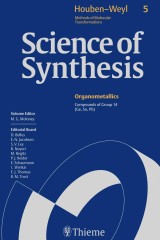Details

Science of Synthesis: Houben-Weyl Methods of Molecular Transformations Vol. 5
Compounds of Group 14 (Ge, Sn, Pb)Science of Synthesis 1. Auflage
|
1.749,99 € |
|
| Verlag: | Thieme |
| Format: | |
| Veröffentl.: | 14.05.2014 |
| ISBN/EAN: | 9783131717511 |
| Sprache: | englisch |
| Anzahl Seiten: | 864 |
Dieses eBook enthält ein Wasserzeichen.
Beschreibungen
<!DOCTYPE HTML PUBLIC "-//W3C//DTD HTML 4.0 Transitional//EN">
<HTML><HEAD>
<META content="text/html; charset=unicode" http-equiv=Content-Type>
<META name=GENERATOR content="MSHTML 8.00.7600.16588"></HEAD>
<BODY>
<P><EM>Science of Synthesis: Houben-Weyl Methods of Molecular Transformations</EM> is the entirely new edition of the acclaimed reference series Houben-Weyl, the standard synthetic chemistry resource since 1909. This new edition is published in English and will comprise 48 volumes published between the years 2000 and 2008.</P>
<P><EM>Science of Synthesis</EM> is a quality reference work developed by a highly esteemed editorial board to provide a comprehensive and critical selection of reliable organic and organometallic synthetic methods. This unique resource is designed to be the first point of reference when searching for a synthesis strategy.</P>
<UL><LI>Contains the expertise of presently 400 leading
chemists worldwide
<LI>Critically evaluates the preparative applicability and
significance of the synthetic methods
<LI>Discusses relevant background information and provides detailed experimental procedures</LI></UL>
<P>For full information on the <EM>Science of Synthesis</EM> series, visit the <A href="http://www.science-of-synthesis.com/">Science of Synthesis Homepage</A></P></BODY></HTML>
<HTML><HEAD>
<META content="text/html; charset=unicode" http-equiv=Content-Type>
<META name=GENERATOR content="MSHTML 8.00.7600.16588"></HEAD>
<BODY>
<P><EM>Science of Synthesis: Houben-Weyl Methods of Molecular Transformations</EM> is the entirely new edition of the acclaimed reference series Houben-Weyl, the standard synthetic chemistry resource since 1909. This new edition is published in English and will comprise 48 volumes published between the years 2000 and 2008.</P>
<P><EM>Science of Synthesis</EM> is a quality reference work developed by a highly esteemed editorial board to provide a comprehensive and critical selection of reliable organic and organometallic synthetic methods. This unique resource is designed to be the first point of reference when searching for a synthesis strategy.</P>
<UL><LI>Contains the expertise of presently 400 leading
chemists worldwide
<LI>Critically evaluates the preparative applicability and
significance of the synthetic methods
<LI>Discusses relevant background information and provides detailed experimental procedures</LI></UL>
<P>For full information on the <EM>Science of Synthesis</EM> series, visit the <A href="http://www.science-of-synthesis.com/">Science of Synthesis Homepage</A></P></BODY></HTML>
&lt;p&gt;5.1 Product Class 1: Germanium Compounds&lt;br&gt;5.1.1 Product Subclass 1: Germanium Hydrides&lt;br&gt;5.1.2 Product Subclass 2: Digermenes and Digermanes&lt;br&gt;5.1.3 Product Subclass 3: Metalated Germanium Compounds&lt;br&gt;5.1.4 Product Subclass 4: Germanium Oxides, Sulfides, Selenides, and Tellurides (Double Bonded)&lt;br&gt;5.1.5 Product Subclass 5: Iminogermanes&lt;br&gt;5.1.6 Product Subclass 6: Germenes&lt;br&gt;5.1.7 Product Subclass 7: Germylenes&lt;br&gt;5.1.8 Product Subclass 8: Organogermanium Halides&lt;br&gt;5.1.9 Product Subclass 9: Germanium Oxides&lt;br&gt;5.1.10 Product Subclass 10: Germanium Carboxylates, Phosphates, and Related Compounds&lt;br&gt;5.1.11 Product Subclass 11: Germanium Sulfides, Sulfoxides, and Related Compounds&lt;br&gt;5.1.12 Product Subclass 12: Germanium Selenides, Tellurides, and Related Compounds&lt;br&gt;5.1.13 Product Subclass 13: Germylamines&lt;br&gt;5.1.14 Product Subclass 14: Germanium Phosphines, Arsines, and Stibines&lt;br&gt;5.1.15 Product Subclass 15: Germanium Cyanides&lt;br&gt;5.1.16 Product Subclass 16: Acylgermanes&lt;br&gt;5.1.17 Product Subclass 17: Imidoylgermanes (&amp;alpha;-Iminoalkylgermanes) and &amp;alpha;-Diazoalkylgermanes&lt;br&gt;5.1.18 Product Subclass 18: &amp;alpha;-Halo- and &amp;alpha;-Alkoxyvinylgermanes&lt;br&gt;5.1.19 Product Subclass 19: &amp;alpha;-Halo-, &amp;alpha;-Hydroxy-, &amp;alpha;-Alkoxy-, and &amp;alpha;-Aminoalkylgermanes&lt;br&gt;5.1.20 Product Subclass 20: Alkynylgermanes&lt;br&gt;5.1.21 Product Subclass 21: Germylketenes and Germylketenimines&lt;br&gt;5.1.22 Product Subclass 22: Aryl- and Heteroarylgermanes&lt;br&gt;5.1.23 Product Subclass 23: Vinylgermanes&lt;br&gt;5.1.24 Product Subclass 24: Propargyl- and Allenylgermanes&lt;br&gt;5.1.25 Product Subclass 25: Benzylgermanes&lt;br&gt;5.1.26 Product Subclass 26: Allylgermanes&lt;br&gt;5.1.27 Product Subclass 27: Alkylgermanes&lt;br&gt;5.2 Product Class 2: Tin Compounds&lt;br&gt;5.2.1 Product Subclass 1: Tin Hydrides&lt;br&gt;5.2.2 Product Subclass 2: Distannenes and Distannanes&lt;br&gt;5.2.3 Product Subclass 3: Metalated Tin Compounds&lt;br&gt;5.2.4 Product Subclass 4: Tin Oxides, Sulfides, Selenides, and Tellurides (Double Bonded)&lt;br&gt;5.2.5 Product Subclass 5: Iminostannanes&lt;br&gt;5.2.6 Product Subclass 6: Stannenes&lt;br&gt;5.2.7 Product Subclass 7: Stannylenes&lt;br&gt;5.2.8 Product Subclass 8: Tin Halides and Organotin Halides&lt;br&gt;5.2.9 Product Subclass 9: Tin Oxides&lt;br&gt;5.2.10 Product Subclass 10: Tin Carboxylates and Phosphates&lt;br&gt;5.2.11 Product Subclass 11: Tin Enol Ethers&lt;br&gt;5.2.12 Product Subclass 12: Tin Sulfides, Thioalkoxides, and Related Compounds&lt;br&gt;5.2.13 Product Subclass 13: Tin Selenides and Tellurides&lt;br&gt;5.2.14 Product Subclass 14: Organostannylamines and Related Compounds&lt;br&gt;5.2.15 Product Subclass 15: Organostannylphosphines&lt;br&gt;5.2.16 Product Subclass 16: Tin Cyanides and Fulminates&lt;br&gt;5.2.17 Product Subclass 17: Acylstannanes (Including S, Se, and Te Analogues)&lt;br&gt;5.2.18 Product Subclass 18: Imidoylstannanes, Diazoalkylstannanes, Tin Isocyanates, and Tin Isothiocyanates&lt;br&gt;5.2.19 Product Subclass 19: 1-Halo-, 1-Alkoxy-, and 1-Aminovinylstannanes&lt;br&gt;5.2.20 Product Subclass 20: 1-Halo-, 1-Hydroxy-, 1-Alkoxy-, and 1-Aminoalkylstannanes&lt;br&gt;5.2.21 Product Subclass 21: Alkynylstannanes&lt;br&gt;5.2.22 Product Subclass 22: Ketenylstannanes and Derivatives&lt;br&gt;5.2.23 Product Subclass 23: Allenylstannanes&lt;br&gt;5.2.24 Product Subclass 24: Arylstannanes&lt;br&gt;5.2.25 Product Subclass 25: Alk-1-enylstannanes&lt;br&gt;5.2.26 Product Subclass 26: Propargylstannanes&lt;br&gt;5.2.27 Product Subclass 27: Benzylstannanes&lt;br&gt;5.2.28 Product Subclass 28: Allylstannanes&lt;br&gt;5.2.29 Product Subclass 29: Alkylstannanes&lt;br&gt;5.3 Product Class 3: Lead Compounds&lt;br&gt;5.3.1 Product Subclass 1: Lead Hydrides&lt;br&gt;5.3.2 Product Subclass 2: Diplumbenes and Diplumbanes&lt;br&gt;5.3.3 Product Subclass 3: Metalated Lead Compounds&lt;br&gt;5.3.4 Product Subclass 4: Organoplumbyl Oxides, Sulfides, Selenides, and Tellurides (Double Bonded)&lt;br&gt;5.3.5 Product Subclass 5: Plumbylenes&lt;br&gt;5.3.6 Product Subclass 6: Halo(organo)plumbanes&lt;br&gt;5.3.7 Product Subclass 7: Organoplumboxanes and Related Compounds&lt;br&gt;5.3.8 Product Subclass 8: Acyloxy(organo)plumbanes&lt;br&gt;5.3.9 Product Subclass 9: Plumbyl Enol Ethers&lt;br&gt;5.3.10 Product Subclass 10: Organoplumbane Sulfur Compounds&lt;br&gt;5.3.11 Product Subclass 11: Organoplumbyl Selenides, Tellurides, and Related Compounds&lt;br&gt;5.3.12 Product Subclass 12: Organoplumbanamines and Related Compounds&lt;br&gt;5.3.13 Product Subclass 13: Organoplumbyl Phosphines and Phosphine Oxides&lt;br&gt;5.3.14 Product Subclass 14: Triorganolead Cyanides and Triorganolead Cyanates&lt;br&gt;5.3.15 Product Subclass 15: Acylplumbanes&lt;br&gt;5.3.16 Product Subclass 16: Lead Isocyanates, Isothiocyanates, Diazoplumbanes, and Iminoplumbanes&lt;br&gt;5.3.17 Product Subclass 17: 1- or 2-Alkoxy- and 1- or 2-(Alkylsulfanyl) and 1- or 2-Aminoalkenyl(triorgano)plumbanes&lt;br&gt;5.3.18 Product Subclass 18: 1-Halo-, 1-Alkoxy-, 1-Hydroxy-, and 1-Aminoalkylplumbanes&lt;br&gt;5.3.19 Product Subclass 19: Alkynylplumbanes&lt;br&gt;5.3.20 Product Subclass 20: Allenylplumbanes&lt;br&gt;5.3.21 Product Subclass 21: Arylplumbanes&lt;br&gt;5.3.22 Product Subclass 22: Vinylplumbanes&lt;br&gt;5.3.23 Product Subclass 23: Benzylplumbanes&lt;br&gt;5.3.24 Product Subclass 24: Allylplumbanes&lt;br&gt;5.3.25 Product Subclass 25: Alkylplumbanes&lt;/p&gt;
Mark G. Moloney

















